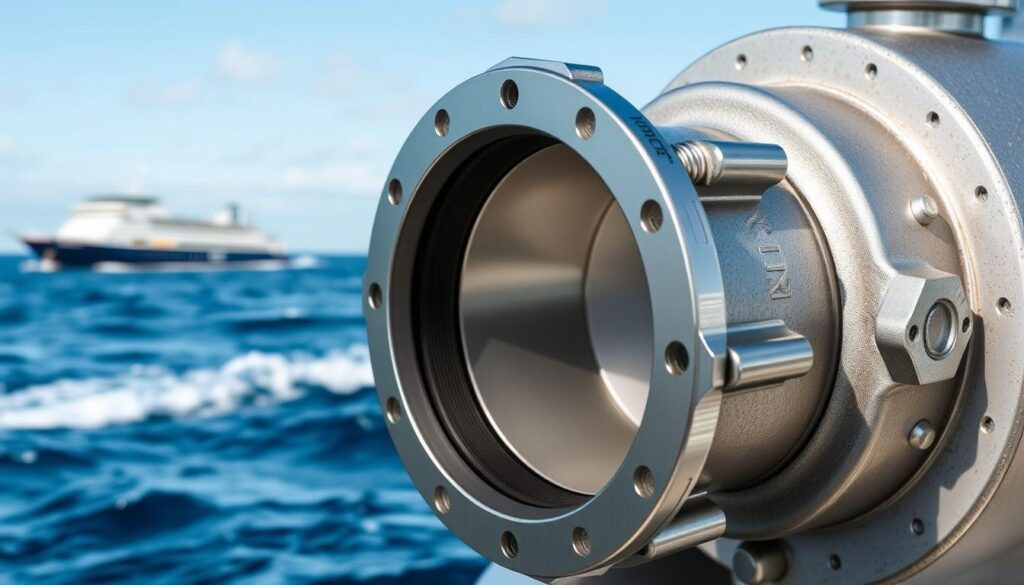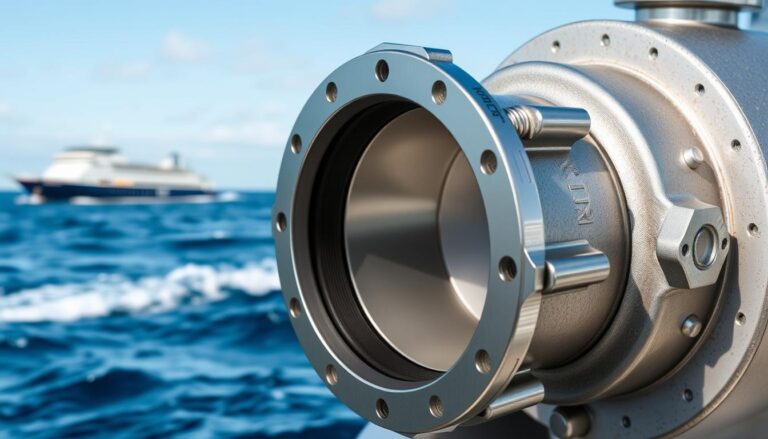A reliable bulkhead fitting is key for any marine project. It makes sure two surfaces are securely and watertight connected. With many bulkhead fitting out there, picking the right one can be tough.
Marine bulkhead fitting are crucial for your vessel’s safety. They keep water out, preventing damage and ensuring safety. Whether you’re building or fixing a vessel, a good bulkhead fitting is essential.

A detailed close-up of a robust marine bulkhead fitting, showcasing its sleek design and sturdy materials, surrounded by a backdrop of a nautical setting with waves and a ship in the distance, emphasizing durability and reliability in marine applications.
We’ll look at different marine bulkhead fitting, their parts, and materials. We’ll also talk about what to look for when choosing a fitting for your project. The right bulkhead fitting is vital for your vessel’s success and safety.
Understanding Bulkhead Fitting in Marine Applications
Bulkhead fitting are key in marine projects, offering a strong and dependable connection for pipes and hoses. It’s vital to know the different bulkhead fitting types and their uses. Marine bulkhead fitting are made to last in harsh marine conditions, fighting off corrosion and damage from seawater and more.
When picking bulkhead fitting materials, think about what your project needs. Materials like stainless steel, bronze, and nylon are common. Stainless steel bulkhead fitting are great for fighting corrosion, while bronze ones are strong and durable.
- Pressure rating and system compatibility
- Material that works well with the environment
- Size and diameter needs
Knowing about the different bulkhead fitting types helps you pick the right one for your marine project. This knowledge ensures your project is safe and works well, avoiding damage and downtime.
Essential Features of Quality Marine Bulkhead Fitting
Choosing the right bulkhead fitting for your marine project is key. Look for features that ensure a strong and secure connection. These fittings must handle the tough marine environment well.
Important features include material selection, design, and construction. The material should resist corrosion and handle marine pressure. A good design means a tight fit, and strong construction means it lasts longer. Also, look for secure threading and leak-resistant seals for safety.
Marine bulkhead fitting features depend on your project’s needs. But, quality fittings usually have:
- High-quality materials and construction
- Secure threading and leak-resistant seals
- Corrosion-resistant coatings or materials
- Durable and long-lasting design
By focusing on these features, you’ll find a fitting that meets your project’s needs. Quality bulkhead fitting are an investment in your project’s safety and success.
| Feature | Description |
|---|---|
| Material Selection | Corrosion-resistant materials, such as stainless steel or bronze |
| Design | Secure and leak-resistant design, with features such as threading and seals |
| Construction | Durable and long-lasting construction, with high-quality materials and craftsmanship |
Choosing the Right Bulkhead Fitting for Your Vessel
Choosing the right bulkhead fitting is key for your marine vessel’s safety and efficiency. You need to consider the size, material, and pressure rating. These factors are crucial for a reliable and secure connection.
Start by looking at the size and diameter of the fitting. It must match your vessel’s systems and needs. Also, think about the material’s compatibility. Some materials resist corrosion better, which is important for the fitting’s life.
Key Considerations for Bulkhead Fitting Selection
- Size and diameter: Ensure the fitting is compatible with your vessel’s systems and intended application.
- Material compatibility: Choose a material that is resistant to corrosion and can withstand the operating conditions.
- Pressure rating requirements: Select a fitting that can handle the maximum pressure rating required for your vessel.
By carefully evaluating these factors, you can find the right bulkhead fitting. Remember to focus on size, material, and pressure rating. This will help you make a well-informed choice.
Professional Installation Guide for Bulkhead Fitting
Installing bulkhead fitting requires a careful plan for a secure connection. A marine bulkhead fitting guide offers valuable insights and step-by-step instructions. We’ll cover the essential steps of installation, including preparation, mounting, and safety.
Before starting, prepare the area and gather tools and materials. Clean the bulkhead, check for damage, and ensure all parts fit well. A good preparation helps avoid problems and makes the installation smoother.
Step-by-Step Mounting Process
The mounting process has key steps like measuring, marking, drilling, and securing. Following a marine bulkhead fitting guide is crucial. It ensures each step is done right and the fitting is secure. This way, you get a reliable connection that can handle different conditions.
Safety Considerations and Best Practices
Safety is a top concern during installation. Take precautions to avoid injuries, ensure the fitting is secure, and follow best practices. By focusing on safety and following a guide, you can have a successful installation.
Maintenance and Care Tips for Marine Fittings
Regular marine fitting maintenance is key to keeping it in top shape. It helps avoid expensive repairs. Simple marine bulkhead fitting tips can make your connection reliable and secure. Start by checking your fittings often for wear, corrosion, or damage.
Keeping a good it care routine is important. Clean your fittings to remove dirt, grime, or marine growth. This keeps the fitting strong and prevents leaks or failures. Also, think about using a protective coating or lubricant to fight off friction and corrosion.
- Regularly check the fitting’s pressure rating and material compatibility
- Ensure proper installation and mounting to prevent stress or damage
- Keep the fitting and surrounding area clean and dry
By sticking to these marine fitting maintenance tips, you can have a secure connection for your marine projects. Always remember to inspect and maintain regularly. This way, you can make it last longer and avoid problems.
Common Challenges and Troubleshooting Solutions
Dealing with it can be tricky. it challenges include leaks and corrosion. These issues can cause downtime and expensive repairs. It’s key to use it leak prevention strategies to avoid these problems.
Here are some common issues and how to fix them:
- Leaks: Look for damage or wear around the fitting. Tighten loose parts and replace damaged ones.
- Corrosion: Check the fitting for corrosion and clean it when needed. Use a protective coating to stop further damage.
- Clogs: Find and remove any blockages in the fitting. Use a filter or strainer to keep debris out.
To solve marine it troubleshooting problems, you need to know your system well. Fixing issues early can make your fittings last longer and work better.
| Challenge | Troubleshooting Solution |
|---|---|
| Leaks | Inspect and tighten connections, replace damaged parts |
| Corrosion | Inspect and clean, apply corrosion-resistant coating |
| Clogs | Check and clean out blockages, use a filter or strainer |
Advanced Applications and Special Considerations
When dealing with advanced bulkhead fitting applications, several factors come into play. These fittings are crucial in marine settings, like offshore oil and gas. Here, marine it special considerations are key. The unique demands of these areas require specific knowledge and tools.
High-pressure systems, corrosive environments, and extreme temperatures are common challenges. In such cases, the fittings must be robust and reliable. They need to handle harsh conditions safely and efficiently. Here are some key considerations for advanced bulkhead fitting applications:
- Material selection: The fitting’s material must match the fluid or gas it carries and withstand the conditions.
- Pressure rating: It must handle the maximum operating pressure and any sudden increases.
- Corrosion resistance: The fitting should resist corrosion from the carried fluid or gas and external factors.
Understanding advanced it applications and marine it special considerations is crucial. This ensures your fitting meets your needs and operates safely. Whether in offshore oil and gas or other marine fields, it’s vital to address the project’s unique challenges. Choose the fitting that best fits your project’s needs.
Conclusion: Ensuring Long-Term Success with Your Marine Bulkhead Fitting
When starting your marine projects, picking the right it is key. This article has given you the tools to make sure your marine bulkhead fitting work well for a long time. They will keep your connection safe and strong.
Think about the size, material, and how much pressure they can handle. Also, install them right, keep them up, and fix any problems fast. This will stop leaks and make your reliable bulkhead fitting last longer.
With the tips from this article, you’re ready to handle marine bulkhead fitting. Focus on quality and follow the steps we’ve shared. You’ll have a secure and worry-free time on the water.
FAQ
What is a bulkhead fitting?
it is key in marine settings. It makes sure a watertight seal between two surfaces. It lets pipes or wires go through while keeping the structure strong.
What are the common types of marine bulkhead fittings?
You’ll find several types of marine it. These include threaded, flanged, compression, and cam-lock fittings. Each type has its own benefits, depending on your project’s needs.
What are the key components and materials used in bulkhead fitting?
it made from durable materials like stainless steel, bronze, or brass. These materials resist corrosion well. The fittings have a body, a connection type, a gasket, and sometimes nuts or clamps.
What are the essential features to consider when choosing a quality marine bulkhead fitting?
Look for material compatibility, pressure rating, and temperature resistance when picking a fitting. The design and construction also matter. It’s vital to choose a fitting that meets your project’s needs and can handle marine conditions.
How do I choose the right size and diameter of a bulkhead fitting for my vessel?
Pick a fitting that matches your application’s size and diameter needs. This ensures a tight fit for your pipe, wire, or component.
What material compatibility factors should I consider for my bulkhead fitting?
Material compatibility is crucial. Make sure the fitting’s materials match the surrounding surfaces and components. This prevents corrosion and ensures a lasting connection.
How do I properly install a bulkhead fitting?
Installing a fitting right is key for a secure connection. Start with preparation like measuring and cleaning. Follow the mounting steps carefully and keep safety in mind.
How do I maintain and care for my marine bulkhead fitting?
Regularly check, clean, and apply protective coatings to your fittings. Following the manufacturer’s care tips helps keep them in good shape.
What are some common challenges and troubleshooting solutions for bulkhead fitting?
Leaks, corrosion, and worn-out fittings are common issues. Use strategies to prevent leaks and address corrosion. Know when to replace fittings to keep your connections reliable.
Are there any advanced applications or special considerations for bulkhead fitting?
Yes, it used in specialized areas like offshore oil and gas platforms. These applications require specific materials and designs to handle unique challenges.


